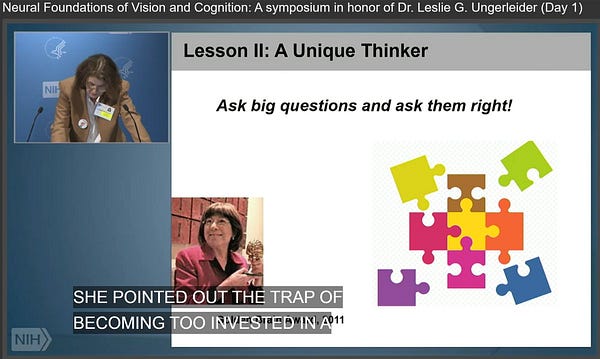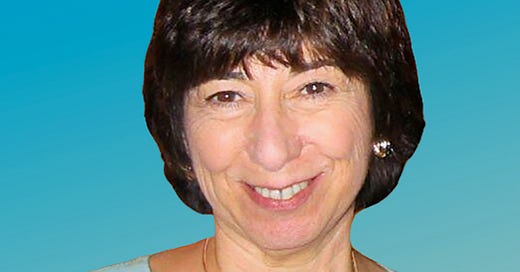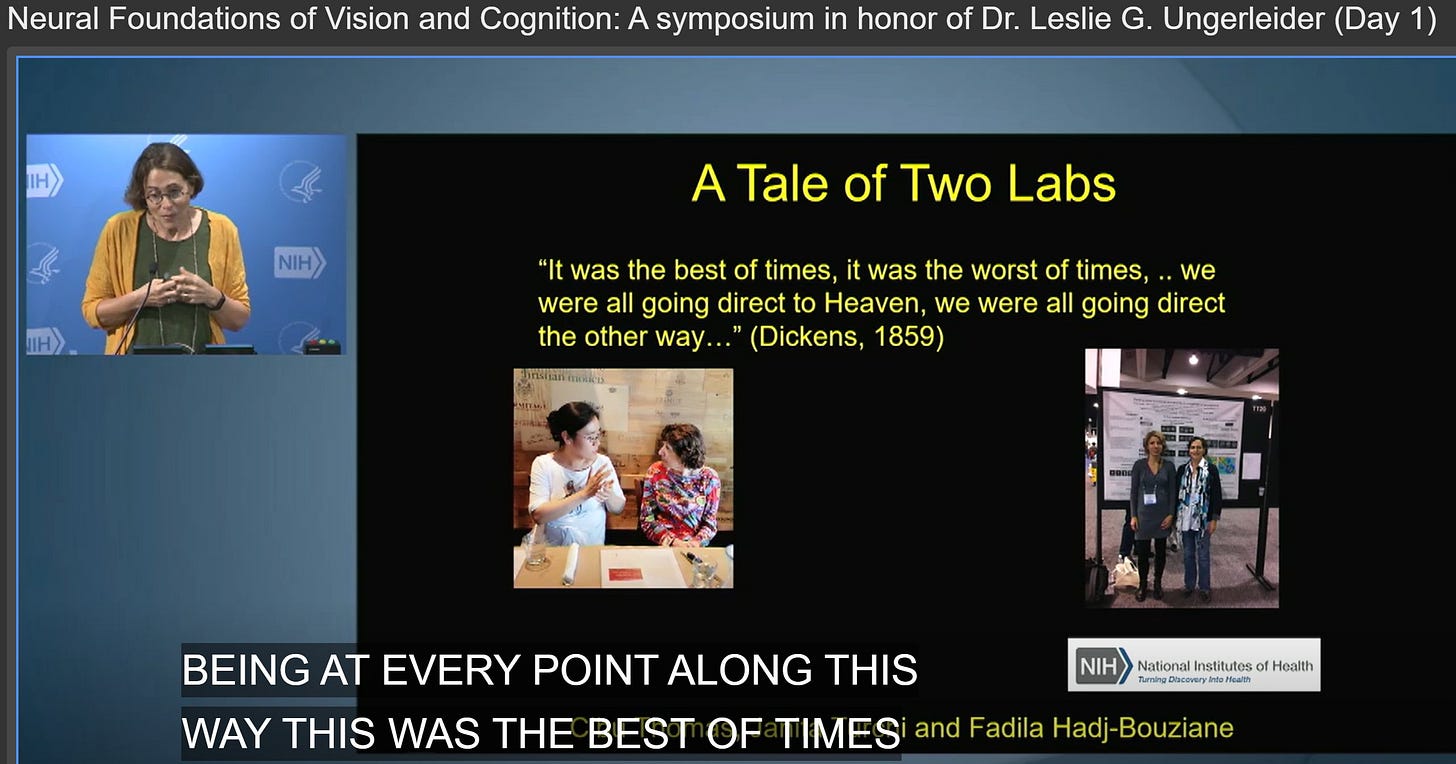Leslie Ungerleider's SciComm Legacy
Dr. Ungerleider was a great scientist and science communicator. What lessons can we learn from her life and work to train the next generation of scientists?
The other day, I (Sheeva) virtually attended a seminar hosted at the National Institutes of Health (NIH) remembering the legendary scientist and person, Dr. Leslie Ungerleider. (At some point, both days of the two-day event will be posted here, if you are interested in watching it.) While I had never met Leslie, I had read about and heard about her numerous contributions to the field of neuroscience, helping elucidate different brain networks and shed light on the different neural bases of our cognition. She is famous for her work with Mortimer Mishkin at NIH (working onstaff there before joining the faculty) illuminating the “what” and “where” visual pathways through detailed animal studies. She even spent a year teaching here in Oklahoma before joining the NIH, as this article detailing her multiple extraordinary careers notes. Pretty wild!
I was excited to tune into the conference to revisit my life as a scientist, and watched as much as I could. I was surprised to take away from the conference with an understanding of what makes a good scientist, colleague, and friend. In this newsletter, I recap a few lessons I learned from the conference that can help guide our training of scientists and science communicators.
The NIH remembrances of Leslie celebrated her as a scientist and colleague, but also as a friend who created family wherever she went; a tireless editor and advocate for her mentees; and an advocate for clarity of thought in developing and testing hypotheses. I was taken aback by this, because working at the highest levels of academic science, people are rarely celebrated for being a good friend. They’re celebrated for groundbreaking contributions to science, getting that Nature or Science paper, and collecting scientific accolades.
Leslie’s remembrance helped me reconsider what it takes to be a good scientist, especially as a woman in science. Women face tons of biases trying to make it as a scientist, such as a citation bias which makes their work less visible in the science community; various kinds of discrimination and stereotyping; and more. Remember the now-infamous retracted Nature Communications paper that said that if you want to be successful in science, you should opt for a male mentor? I previously reported on it for The Xylom. Science’s culture problem is no secret.
Despite being a woman in science at a time when that was less common, Leslie blazed a new path in science and made tons of friends along the way. Over the course of the two-day symposium, many of her fellow neuroscientists shared stories about Leslie, detailing both personal and professional ties to her. Leslie made friends wherever she went, and was always laser-focused on doing good science and communicating it effectively.
These days, there are a lot of ways to study the human brain noninvasively (you can read about the many different brain imaging methods over on our blog), but it wasn’t always the case. Functional magnetic resonance imaging or fMRI was invented in the early 1990s. I think you’ve probably seen fMRI covered in the news, as it tends to get tons of ‘pop science’ attention by the news media. These days, even dogs’ brains can be studied with fMRI, as I recently blogged.
Despite fMRI’s infancy, Leslie was able to use it, as well as other more established tools, such as neurophysiology (recording electrical and magnetic signals of the brain) as well as structural MRI to get at the brain’s structure and function. She used these different imaging methods to piece together brain structure-function relationships. Leslie made sense of brain networks and rhythms by putting the data from different imaging methods together, like pieces of a puzzle.





While I never met her, Leslie strikes me as the kind of person who aggressively pursued her scientific interests despite all odds, making the impossible possible through hard work. At one point in her life, Leslie ran three labs (!) at the National Institutes of Health. Wow. As a result, she was able to expand science in ways that were previously not possible.


I also have a lot of interests, so I can relate. I am a scientist, science writer, and political wonk. In my mind, I am also running multiple “labs”…and they all go together, even if not in an obvious way. I think a lot of freelancers can relate; we often juggle multiple projects that are near and dear to us. What kinds of breakthroughs can we make if we pursue our passions and never give up?

What surprised me the most about Leslie and the way her colleagues remembered her was her commitment to science communication or SciComm. I often hear from professors that they are too busy with all their different tasks to pursue science communication or work on improving their public-facing communications skills. Maybe it was different for Leslie; as a researcher at the NIH, teaching students is not as much a part of your job, so perhaps she had more time to work on her communication skills and impart this knowledge to others. This makes me wonder about the way we do science; clearly, scientists and scientists-in-training shouldn’t be overwhelmed with too many tasks, but is there a way to prioritize science communication?
Perhaps it is because Leslie was such a fierce advocate for SciComm that she was so successful. She had tons of collaborators; she bridged disciplinary divides to yield new findings; she published tons of papers; and she unlocked tons of the brain’s mysteries in the process. It makes me think that SciComm is key to doing good science, and that we should make time for SciComm for undergraduate and graduate students of science.
What would this look like in practice? I think it would look a lot like what Leslie did to help her mentees.
If Leslie was reviewing a manuscript, she would print it out and read it, and make comments. She would then have a meeting with the mentee, and review her comments with them, which were things like:
“Confusing.”
“What’s the story?”
“Too much statistics, not enough explanation as to what they mean.”
She would do the same helping her mentees prepare for talks.

As a woman in science, I was surprised to learn that it’s possible to succeed at such a high level in science despite sexism. I have been lucky to have benefitted from the mentorship of many women scientists, but honestly, I never really understood how any of my women mentors made it to the top levels of neuroscience.
After watching this seminar, now I realize that being a good scientist is just like being a good anything else. It’s not about being a sociopath and alienating people to get a bunch of science done; it’s by making connections with people and working hard to ask and answer research questions that can reveal foundational truths in science.


Dr. Susan Courtney, one of Leslie’s colleagues, says of the late scientist, “She never rested on her laurels. She continued to question assumptions and push for better understanding.”
I often think about what makes a good scientist, and whether I am one. The answer is that I am, or more technically, I used to be (though I’m still working on publishing my science projects). I have two degrees in neuroscience from MIT and Georgetown and have over a decade of research experience as a scientist. These days, though, my job title is ‘freelance science writer and strategist.’ That’s not to say that I don’t apply my scientific skills and experience to my current job, but I do not spend my days in the lab. Leslie’s life and work, for me, redefines what it means to be a scientist - reminding me that writing is an essential part of science that we often take for granted.
Throughout my own scientific career, I have noticed that the scientists who are good at writing and communicating are most successful - and weirdly, the people I have met who are the best at this, and take the time to communicate well, are women.
Over the past few years as a science freelancer, I’ve met a lot of scientists turned science writers, mostly women. Some of us have left PhD programs because they didn’t work out; others made the choice to leave to pursue the writer’s life. I’ve rarely met anyone who understood the career path I have carved out for myself. My career choices in science communication and science policy have been called “unglamorous.” Yet, as a scientist, it was tough to get taken seriously. As a result, I discounted myself and my skills because I internalized society’s narratives about what a scientist looks like, or what they do. Seems like nobody imagines a scientist editing a manuscript mercilessly, or preparing for a talk — but those are really important aspects of doing science.
After watching this NIH seminar, I realize that communication is just a part of science as developing and testing hypotheses, and the people who can write and speak well are the people who make impactful discoveries. I feel lucky to have been able to learn about Leslie’s life and her SciComm legacy.
What we’ve been reading (and writing):
Maybe I am weird, but I rarely experience writer’s block. Perhaps it is because I don’t write when I don’t have anything to say. Writer Rabih Alameddine says that the concept of writer’s block is “a masculine concept. You must write, you must produce, you must work hard or else.” Read his full take at Literary Hub.
You’ve heard of business-to-business (B2B) or business-to-consumer (B2C) writing, but have you heard of business-to-employee or B2E writing? Angela Tague introduces it here.
Matthew Fenton recaps lessons he’s learned over 25 years of freelancing; Harlow talks about ways to avoid burnout.
From Reddit: “I read 100 marketing papers and these are the most interesting 11 findings.”
Over at the Fancy Comma blog, we’ve been blogging about freelancer time-savers, fast ways to come up with Twitter content, and advocating for your small business in Congress.
Thanks for reading! If you liked our newsletter, please share it on social media!




